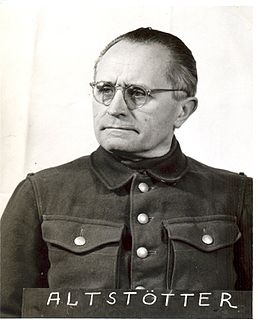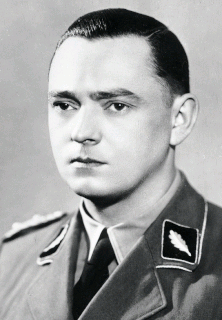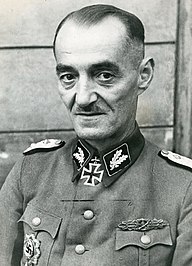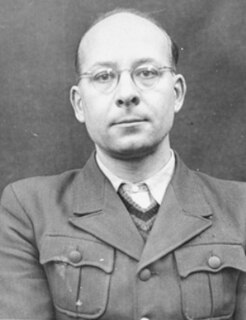 W
WOberführer was an early paramilitary rank of the Nazi Party (NSDAP) dating back to 1921. An Oberführer was typically a NSDAP member in charge of a group of paramilitary units in a particular geographical region. From 1921 to 1925, the phrase Oberführer was used as a title in the Sturmabteilung (SA), but became an actual SA rank after 1926.
 W
WJosef Altstötter was a high-ranking official in the German Ministry of Justice under the Nazi Regime. Following World War II, he was tried by the Nuremberg Military Tribunal as a defendant in the Judges' Trial, where he was acquitted of the most serious charges, but was found guilty of a lesser charge of membership in a criminal organization.
 W
WBenno von Arent was a German film director, artist, architect, designer and a member of the Nazi Party and SS.
 W
WOtto Baum was a high-ranking commander (Oberführer) of the Waffen-SS during World War II. He was a recipient of the Knight's Cross of the Iron Cross with Oak Leaves and Swords of Nazi Germany.
 W
WGeorg Bochmann was a high-ranking commander and Oberführer in the Waffen-SS who commanded the SS Division Götz von Berlichingen and the SS Division Horst Wessel. He was a recipient of the Knight's Cross of the Iron Cross with Oak Leaves and Swords.
 W
WSS-Oberführer Ernst Boepple was a Nazi official and SS officer, serving as deputy to Josef Bühler in occupied Poland during World War II and the Holocaust, who was executed for war crimes.
 W
WHorst Böhme was a German SS functionary during the Nazi era. He served in the SD, the intelligence service of the SS, and was a leading perpetrator of the Holocaust.
 W
WViktor Hermann Brack was a member of the Schutzstaffel (SS) and a convicted Nazi war criminal, who was one of the prominent organisers of the euthanasia programme Action T4; this Nazi initiative resulted in the systematic murder of over 70,000 disabled German and Austrian people. He held various positions of responsibility in Hitler's Chancellery in Berlin. Following his role in the T4 programme, Brack was one of the men identified as responsible for the gassing of Jews in extermination camps, having conferred with Odilo Globočnik about its use in the practical implementation of the Final Solution. Brack was sentenced to death in 1947 and executed by hanging in 1948.
 W
WPrince Christoph Ernst August of Hesse was a nephew of Kaiser Wilhelm II. He was a German SS officer and was killed on active duty in a plane crash during World War II. His brother-in-law, Prince Philip of Greece and Denmark, fought on the British side and married the future Queen Elizabeth II after the war.
 W
WEduard Deisenhofer was a German commander in the Waffen-SS of Nazi Germany. He was an early member in the SS, and served with the Leibstandarte SS Adolf Hitler and at the Dachau concentration camp in 1930s. During World War II, Deisenhofer served with several combat divisions on both the Eastern and Western fronts, earning the Knight's Cross of the Iron Cross. He held a PhD in political economy.
 W
WHeinrich Deubel was a German soldier, civil servant, World War I veteran and officer in the Schutzstaffel who served as commandant of Dachau concentration camp.
 W
WKarl Diebitsch was an artist and the Schutzstaffel (SS) officer responsible for designing much of the SS regalia during the Nazi era, including the chained SS officer's dagger scabbard. Diebitsch worked with graphic designer Walter Heck to draft the well-known all-black SS uniform. Also with his business partner, industrialist Franz Nagy, Diebitsch began the production of art porcelain at the factory Porzellan Manufaktur Allach.
 W
WRudolf Diels was a German civil servant and head of the Gestapo in 1933–34. He obtained the rank of SS-Oberführer and was a protégé of Hermann Göring.
 W
WOskar Paul Dirlewanger was a German military officer (SS-Oberführer) and war criminal who served as the founder and commander of the Nazi SS penal unit "Dirlewanger" during World War II. Serving in Poland and in Belarus, his name is closely linked to some of the most notorious crimes of the war. He also fought in World War I, the post-World War I conflicts, and the Spanish Civil War. He reportedly died after World War II while in Allied custody. According to Timothy Snyder, "in all the theaters of the Second World War, few could compete in cruelty with Dirlewanger".
 W
WAlexander Freiherr von Dörnberg zu Hausen was a German jurist, diplomat and SS officer. He was head of the Protocol Department of the Foreign Office from 1938 to 1945.
 W
WErich Ehrlinger was a member of the Nazi Party and SS. As commander of Special Detachment 1b, he was responsible for mass murder in the Baltic states and Belarus.
 W
WHeinrich Fehlis was a German Schutzstaffel (SS) officer during World War II. He commanded the Sicherheitspolizei (SiPo) and Sicherheitsdienst (SD) in Norway and Oslo during the German occupation of Norway.
 W
WOberführer and Oberst of Police Wilhelm Fuchs was a Nazi Einsatzkommando leader. From April 1941 to January 1942 he commanded Einsatzgruppe Serbia. From 15 September 1943 through 27 May 1944 he commanded Einsatzkommando 3. He was executed by hanging in Belgrade.
 W
WErhard Kroeger or Kröger was a Baltic German SS officer involved in the resettlement of Baltic Germans before World War II. He commanded an Einsatzgruppe in 1941, and was later attached to General Andrey Vlasov and the German sponsored Russian Liberation Army of World War II. He was convicted of war crimes in 1969.
 W
WOberführer Hans Loritz joined the SS in September 1930 and the NSDAP in August 1930. In 1933, he formed and commanded the SS Standarte at the Dachau concentration camp.
 W
WEmil Maurice /e.mil mo.ʁis/ was an early member of the National Socialist German Workers' Party and a founding member of the Schutzstaffel (SS). He was Hitler's first personal chauffeur, and was one of the few persons of mixed Jewish and ethnic German ancestry to serve in the SS, being declared an honorary Aryan by Adolf Hitler in 1935.
 W
WRudolf Mentzel PhD was a German chemist and a National Socialist science policy-maker. An influential figure and one of the leading science administrators in Germany's nuclear energy project, Mentzel served as the scientific and technical adviser on the development of atomic bombs to the German government, and on some part, as the director of this program. Originally a National Socialist by political orientation, Mentzel served as one of the top leading science policy-makers to Adolf Hitler and his cabinet in his role as an undersecretary of the Reich Ministry of Education (REM) in the Office for Science. In the Kaiser Wilhelm Society, he was on the advisory board and, during World War II, Second Vice President of the Kaiser Wilhelm, supervising the clandestine research critical to develop the atomic bombs. During this period, his sphere of responsibility also momentarily grew and he soon was appointed as the president of the German Association for the Support and Advancement of Scientific Research, acting as the director of the nuclear program.
 W
WKonrad Meyer-Hetling was a German agronomist and SS-Oberführer. He is best known for his involvement in the development of Generalplan Ost.
 W
WJoachim Mrugowsky was a German bacteriologist who conducted experiments on humans at the Sachsenhausen concentration camp. He was Associate Professor, Medical Doctorate, Chief of Hygiene Institute of the Waffen-SS, Senior Hygienist at the Reich, SS-Physician, SS and Waffen-SS Colonel. He was found guilty of war crimes following the war in the Doctors' Trial and executed in 1948.
 W
WKajetan "Kai" Mühlmann was an Austrian art historian who was an officer in the SS and played a major role in the expropriation of art by the Nazis, particularly in Poland and the Netherlands. He worked with Arthur Seyss-Inquart in the initial Nazi government in Vienna following the Anschluss, in the General Government and in The Hague where he headed an organisation known as the Dienststelle Mühlmann which functioned as a clearing house for art expropriated in the occupied Netherlands. He has been characterised as one of the greatest art thieves among the Nazis, and possibly ever.
 W
WErich Neumann was a Nazi politician.
 W
WFriedrich Panzinger was a German SS officer during the Nazi era. He served as the head of the Reich Security Main Office (RSHA) Amt IV A, from September 1943 to May 1944 and the commanding officer of three sub-group Einsatzkommando of Einsatzgruppen A in the Baltic States and Belarus. From 15 August 1944 forward, he was chief of RSHA Amt V, the Kriminalpolizei. After the war, Panzinger was arrested in 1946 and imprisoned by the Soviet Union for being a war criminal. Released in 1955, he was a member of the Bundesnachrichtendienst. In 1959, Panzinger committed suicide in his jail cell after being arrested for war crimes.
 W
WHermann Pister was an SS Oberführer and commandant of Buchenwald concentration camp from 21 January 1942 until April 1945.
 W
WHelmut Poppendick was a German doctor who served in the SS during World War II. He was an internist and worked in the Medical Doctorate, as Chief of the Personal Staff of the Reich Physician SS and Police. After the war he was a defendant in the Doctors' Trial.
 W
WFerdinand Porsche was a German automotive engineer and founder of the Porsche car company. He is best known for creating the first gasoline-electric hybrid vehicle (Lohner-Porsche), the Volkswagen Beetle, the Auto Union racing car, the Mercedes-Benz SS/SSK, several other important developments and Porsche automobiles.
 W
WEmanuel Schäfer was a high-ranking SS functionary (SS-Oberführer) and a protégé of Reinhard Heydrich in Nazi Germany.
 W
WJulian Scherner was a Nazi Party official and a high-ranking member in the SS of Nazi Germany. During World War II, he served as the SS and Police Leader of Kraków, Germany-occupied Poland.
 W
WEmil Sembach was an SS-Oberführer attached to the SS headquarters of Silesia.
 W
WOtto Steinhäusl was an Austrian-born SS-Oberführer, Polizeipräsident of Vienna, and President of Interpol (1938–1940).
 W
WKarl Ullrich was the last commander of the SS Division Wiking in the Waffen-SS of Nazi Germany during World War II. After the war he authored an account of the SS Division Totenkopf.
 W
WArpad Jakob Valentin Wigand was a Nazi German war criminal with the rank of SS-Oberführer who served as the SS and Police Leader in Warsaw (SS-und Polizeiführer from 4 August 1941 until 23 April 1943 during the occupation of Poland in World War II.
 W
WWalther Wüst was a German Indologist who served as Rector of the University of Munich from 1941 to 1945.